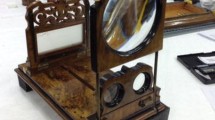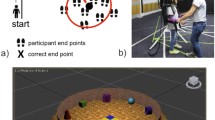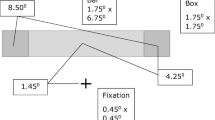Abstract
Although there are many well-known forms of visual cues specifying absolute and relative distance, little is known about how visual space perception develops at small temporal scales. How much time does the visual system require to extract the information in the various absolute and relative distance cues? In this article, we describe a system that may be used to address this issue by presenting brief exposures of real, three-dimensional scenes, followed by a masking stimulus. The system is composed of an electronic shutter (a liquid crystal smart window) for exposing the stimulus scene, and a liquid crystal projector coupled with an electromechanical shutter for presenting the masking stimulus. This system can be used in both full- and reduced-cue viewing conditions, under monocular and binocular viewing, and at distances limited only by the testing space. We describe a configuration that may be used for studying the microgenesis of visual space perception in the context of visually directed walking.
Similar content being viewed by others
References
Adams, M. J. (1979). Models of word recognition. Cognitive Psychology, 11, 133–176. doi:10.1016/0010-0285%2879%2990008-2
Breitmeyer, B. G., & Öğmen, H. (2000). Recent models and findings in visual backward masking: A comparison, review, and update. Perception & Psychophysics, 62, 1572–1595.
Breitmeyer, B. G., & Öğmen, H. (2006). Visual masking: Time slices through conscious and unconscious vision. New York: Oxford University Press.
Fikes, T. G., Klatzky, R. L., Pellegrino, J., Hebert, C., & Murdock, L. (1990). Tachistoscopic exposure of real objects for measurement of reaction time and movement time. Behavior Research Methods, Instruments, & Computers, 22, 290–296.
Foley, J. M. (1978). Primary distance perception. In R. Held, H. W. Leibowitz, & H.-L. Teuber (Eds.), Handbook of sensory physiology: Vol. VIII. Perception (pp. 181–213). Berlin: Springer.
Foley, J. M., & Richards, W. (1972). Effects of voluntary eye movement and convergence on the binocular appreciation of depth. Perception & Psychophysics, 11, 423–427.
Gegenfurtner, K. R., & Sperling, G. (1993). Information transfer in iconic memory experiments. Journal of Experimental Psychology: Human Perception & Performance, 19, 845–866. doi:10.1037/0096-1523.19.4.845
Irwin, D. E., & Yeomans, J. M. (1986). Sensory registration and informational persistence. Journal of Experimental Psychology: Human Perception & Performance, 12, 343–360. doi:10.1037/0096-1523.12.3.343
Klatzky, R. L., Lederman, S. J., & Matula, D. E. (1993). Haptic exploration in the presence of vision. Journal of Experimental Psychology: Human Perception & Performance, 4, 726–743. doi:10.1037/0096-1523.19.4.726
Lehmkuhle, S., & Fox, R. (1980). Effect of depth separation on metacontrast masking. Journal of Experimental Psychology: Human Perception & Performance, 6, 605–621. doi:10.1037/0096-1523.6.4.605
Loomis, J. M., Da Silva, J. A., Fujita, N., & Fukusima, S. S. (1992). Visual space perception and visually directed action. Journal of Experimental Psychology: Human Perception & Performance, 18, 906–921. doi:10.1037/0096-1523.18.4.906
Loomis, J. M., Da Silva, J. A., Philbeck, J. W., & Fukusima, S. S. (1996). Visual perception of location and distance. Current Directions in Psychological Science, 5, 72–77. doi:10.1111/1467-8721.ep10772783
Philbeck, J. W. (2000). Visually directed walking to briefly glimpsed targets is not biased toward fixation location. Perception, 29, 259–272.
Philbeck, J. W., Loomis, J. M., & Beall, A. C. (1997). Visually perceived location is an invariant in the control of action. Perception & Psychophysics, 59, 601–612.
Potter, M. C. (1976). Short-term conceptual memory for pictures. Journal of Experimental Psychology: Human Learning & Memory, 2, 509–522. doi:10.1037/0278-7393.2.5.509
Ryan, T. A., & Schwartz, C. B. (1956). Speed of perception as a function of mode of representation. American Journal of Psychology, 69, 60–69. doi:10.2307/1418115
Sedgwick, H. A. (1986). Space perception. In K. R. Boff, L. Kaufman, & J. P. Thomas (Eds.), Handbook of perception and human performance: Vol. 1. Sensory processes and perception (pp. 21.1–21.57). New York: Wiley.
Thomson, J. A. (1980). How do we use visual information to control locomotion? Trends in Neurosciences, 3, 247–250.
Thomson, J. A. (1983). Is continuous visual monitoring necessary in visually guided locomotion? Journal of Experimental Psychology: Human Perception & Performance, 9, 427–443. doi:10.1037/0096-1523.9.3.427
Vogel, E. K., Woodman, G. F., & Luck, S. J. (2006). The time course of consolidation in visual working memory. Journal of Experimental Psychology: Human Perception & Performance, 32, 1436–1451. doi:10.1037/0096-1523.32.6.1436
Author information
Authors and Affiliations
Corresponding author
Additional information
This work was supported in part by NIH Grant RO1 NS052137 to J.P.
Rights and permissions
About this article
Cite this article
Pothier, S., Philbeck, J., Chichka, D. et al. Tachistoscopic exposure and masking of real three-dimensional scenes. Behavior Research Methods 41, 107–112 (2009). https://doi.org/10.3758/BRM.41.1.107
Received:
Accepted:
Published:
Issue Date:
DOI: https://doi.org/10.3758/BRM.41.1.107




